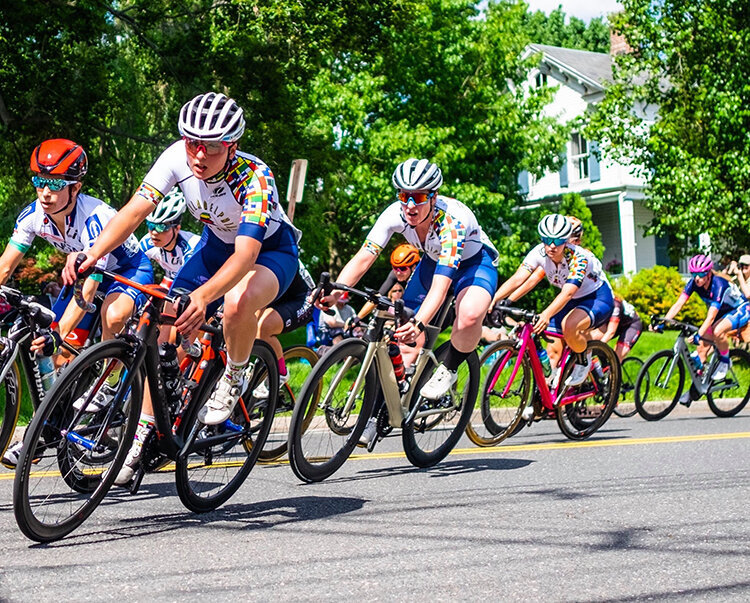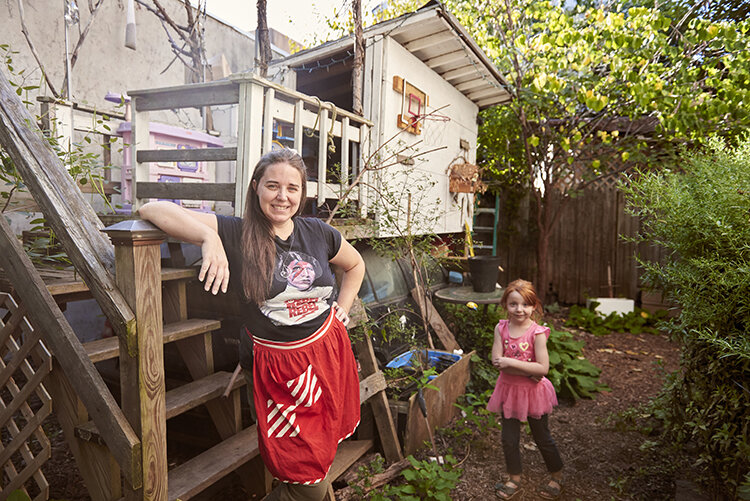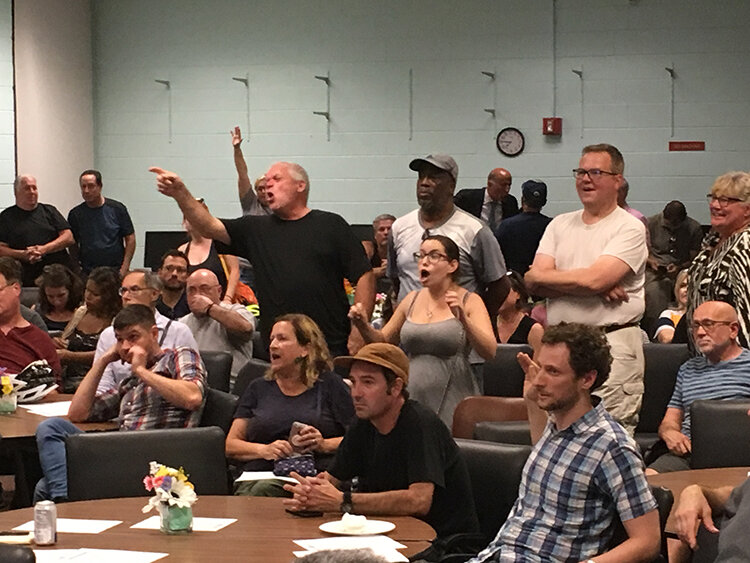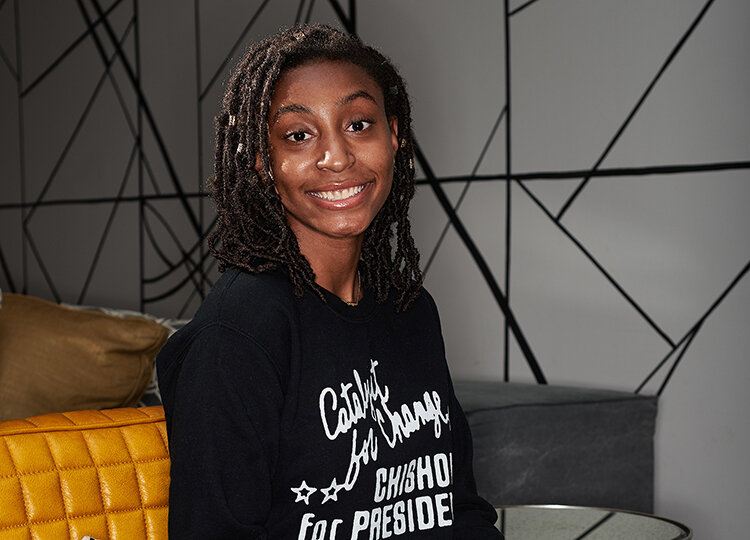Jonathan Purtle and Sara Hirschler make themselves more visible to drivers with orange bicycles and yellow reflective gear. Photography by Linette Kielinski
by Claire Marie Porter
On a Friday afternoon this past summer, Leigh Goldenberg, executive director of Theatre Philadelphia and a cyclist and car-free South Philly resident, was biking home from an event at the Oval with her 4-year-old, Tilde Bea, on the back of her commuter cargo bike. At a stoplight on the corner of Rittenhouse Square, a woman in a car rolled down her window and berated Goldenberg for putting her child in danger.
“The old rules were so much safer,” said the stranger, adding that she would never bike in the street with her child.
“Oh, the rules before there were cars?” was Goldenberg’s retort.
The stranger shook her head dismissively, says Goldenberg, while continuing to tell her how unsafe she was.
Tilde had a lot of questions for her mother after this encounter. What wasn’t safe about biking when “this is what we do all the time?” asked Tilde, who has commuted on a bike with her parents her entire life.
Goldenberg is accustomed to angry and bewildered drivers. During her pregnancy with Tilde, she continued biking, and even got a more upright bike to accommodate her belly in her third trimester. Verbal harassment from drivers, targeted particularly at her pre-motherhood choices, was persistent.
But she never let that stop her.
The two most frequent questions she got while pregnant were: When are you due? And: When are you going to stop biking?
“Never,” said Goldenberg.
At 41 weeks, she was still riding her tandem bike with her husband, Aaron Bauman. She biked up until the day their daughter was born.
When many Americans think of biking with their kids, they probably conjure up an image of a suburban cul-de-sac, and the moment when they push their child off without training wheels for the first time, says Goldenberg.
“When you get a kid in the city,” she says, “it’s this extreme alternative that borders on negligence in many people’s minds.”
Goldenberg herself has never owned a car. She relies solely on her bicycle in a world where “staying out of an SUV seems radical,” she says, and biking is viewed as a leisure activity that’s part of “wholesome American living.”
While car-free households have declined nationally over the past few years, according to the U.S. Census Bureau, Philadelphia boasts the highest rate of households that commute to work via bicycle in the country, at 2.3%.
But, as Goldenberg can attest, relying solely on a bicycle for transportation is much easier said than done when you start having kids.
With a toddler on the back, zig-zagging through traffic, dodging trash cans strewn across bike lanes and dealing with the emotional stress of uninformed rebukes by drivers isn’t very carefree.
“What I wish I’d told this driver, or any others if they would listen, is that riding a bicycle is dangerous because of cars. Car crashes make up the number one cause of death for kids—more than gun violence,” says Goldenberg, “and, that by keeping another car off the road we’re reducing pollution to create a safer environment for my kid’s generation.”
For Goldenberg, living without a car became more complicated when Tilde was born, requiring specialized equipment that needed to be updated every couple of years.
When Tilde was around 6 months old, the couple bought a combination of a stroller and a bike called a Zigo. It looks like a large tricycle with a jogging stroller in the front.
Because Tilde was still too small for a helmet, they installed her car seat inside the Zigo’s carrying compartment. Pulling her around was very slow and exhausting, says Goldenberg, and they had no choice but to take up a car lane.
But, finally, they were able to bike places as a family.
When Tilde was a year and a half, and old enough to fit into a helmet, they outfitted their bike with an iBert, a front-mounted child bike seat that sits between the between the handlebars.
Shortly thereafter, the family updated to an Xtracycle cargo bike, or a “long tail,” a lightweight cargo bike with an area behind the seat where children’s bike seats can easily be installed. They’ve been using that for the past few years.
Now, 5 years old and riding alone, Tilde bikes beside her parents for short distances.
For longer journeys, like the one to school, she still hops in a child seat on the back of her parent’s Yuba Mundo cargo bike. On a typical day, the couple uses this bike to drop off Tilde at school and then returns home to switch to their solo bikes and commute to work—all while navigating angry drivers, perilous sidewalks, inconsistent bike lanes with worn paint and any number of street-strewn obstacles.
The car-free commitment requires thinking about how to live your life more locally, she says. Sometimes that means they’ve had to miss out on some opportunities.
“When you’re a parent, convenience tends to be paramount,” says Goldenberg.
Goldenberg says they constantly need to educate their child, who sometimes has questions after overhearing angry drivers’ shouting at them, about their commitments and choices.
Recently, the family ordered a full-sized street sign that says “may use full lane” and installed it on the back of their cargo bike, hoping it would help to remind drivers that cyclists have a right to the road.
“People have actually honked at me a lot less,” she says.
Christine Knapp, a car-free resident living in South Philly and working as director of the Office of Sustainability in Center City, says biking is not just about the value of reducing her carbon footprint.
“When you walk, bike or take public transportation, you’re engaging with your fellow residents,” says Knapp. “It’s being an active citizen.”
She believes everyone should be able to bike.
“If people live in a neighborhood and don’t feel like they have the tools or infrastructure, that’s a political position. They should vote … and make their voices heard,” says Knapp.
Knapp uses a cargo bike with a large wooden bucket on the front to bike with her child. When transporting her daughter, she feels cars are much more likely to respect her as a cyclist.
“When they see my daughter’s pink helmet, they’re much nicer,” she says.
Knapp says it’s important for drivers to change the way they see cyclists.
“We’re real people,” she says. “People in cars don’t see cyclists as people. We h
ave families and jobs. We’re not the enemy.”
Sara Hirschler, of Northern Liberties, began rethinking her commute when she got pregnant. She started wearing a neon vest and has never stopped.
Her biking setup has transformed as her family has expanded. When she installed a windshield in front of her cargo bike a few years ago, her friends joked that her bike is slowly turning into a car. They jokingly suggested a roof. “Not a bad idea,” was Hirschler’s reply.
“Part of going car-free is to be mindful that you’re probably going to have to evolve,” she says, comparing it to buying a car seat that can grow with the child. On a bicycle, as the child grows, their weight needs to be accommodated in different ways, from front- or back-mounted child seats when they’re smaller, to trailers, trail-a-bikes and tandems when they’re bigger.
On a typical day Hirschler loads up her Yuba Mundo, work items, her two kids’ backpacks and gear for school. Her children, ages one-and-a-half and 4, go to different schools: one near Fairmount and Ridge and one near Logan Square. Each day Hirschler and her husband take one kid each to school and back. More rarely, one of them will take both, she says.
Hirschler, who works for Fairmount Park Conservancy, found biking routes that make her feel safe. There are also routes that she completely avoids.
“It’s an everyday experiment of what feels safe and what doesn’t.” she says. “Block by block.”
“There absolutely are moments where it’s kind of unbelievable how unsafe it can feel,” she admits.
Before having kids, Hirschler says she wouldn’t have dreamed of using the sidewalk. But now, she does whatever it takes.
“I yield to whatever, whoever,” she says. “I want to be safe. That’s really the bottom line.”
If that means pulling over or getting on the sidewalk so an aggressive driver can pass her, she will.
“I feel like I sort of developed this extra sense of who’s behind me or what level of sound their car is emitting, or what energy is coming from them,” she adds.
She’s more careful now than she’s ever been. Both Hirschler and her husband wear neon vests, neon helmets and ride bright-orange longtail cargo bikes.
“You really can’t miss us,” she says. “It’s, like, kind of comical.”
Hirschler says she’s a stickler about cooking most meals at home, which makes car-free life challenging. They sometimes need to rely on grocery-delivery services, which she feels is unfortunate.
“I wish it were a little bit, or a lot, easier to feel supported in not owning a car,” she says.
She says she feels like the bike-friendly momentum that was happening years ago has died down, and the last few years have felt stagnant.
“It doesn’t feel like there’s big energy from the city,” she says. “It’s slow-going and piecemeal—like a stretch of protected lane that spans five blocks.”
But she and her family are committed to never owning a car. Every time they re-evaluate, it seems so obvious, she says.
Commuting by bike or transit, especially in Philly, is often faster. The car-free lifestyle eliminates the mental and financial burden of insurance, car payments and inspections, as well as the pain of city parking.
“In general we’re environmentally conscious people,” she says. “But at the same time, from a cost perspective it doesn’t make any sense [to own a car].”
Hirschler thinks there is a great amount of potential for Philly to be a bike- and family-bike-friendly city, and to get many more people commuting on bike, but installing more protective infrastructure is the only way it could happen.
“Making safer infrastructure is the only way biking will be possible for more people,” she says. “That would be such an important thing for the city to do in the face of climate change.”
Goldenberg echoes Hirschler’s sentiment. “If we’re going to be talking about climate change, and a green new deal—the lack of investment for pedestrians, cyclists and [public] transit is a problem,” she says.
She thinks the city needs to do more than just repaint its existing bike lanes.
“Paint is not infrastructure,” says Goldenberg. She feels that the city treats both pedestrians and cyclists as an afterthought.
“I feel very let down by our elected officials,” she says. “We are also taxpayers and residents.”
Her husband made a bot on Twitter, @everylanephilly, in which he posts every lane in the city that’s considered a bike lane according to Google Maps’ street view. Some of the photos show views of lanes obstructed by parked vehicles, piles of leaves and paint that has worn away.
“Imagine taking your 5-year-old on some of these lanes,” says Goldenberg. “It’s shameful.”
And they don’t travel as far as some other families might. Both she and her husband only live two miles away from work, and they have good schools nearby.
“We recognize we’re able to make this choice because we can afford to live near where we work,” she says, acknowledging her privilege. “There are certainly families who wouldn’t be able to do this.”
In an ideal world, city officials might see that biking around the city fosters a sense of community that driving cannot.
“Living in a city is sharing space,” Goldenberg says. “We’re on our bike, waving at friends, observing things.”
“We’re a part of the city,” she says, “in a way you can’t be in a car.”











I ride in CC all the time. I always wear my High Vis Vest and dorky looking High Vis Helmet. For example: 21st and Walnut to 10th and Race (5 mins). On streets that say, "may use full lane", that’s what I do, I use the full lane!